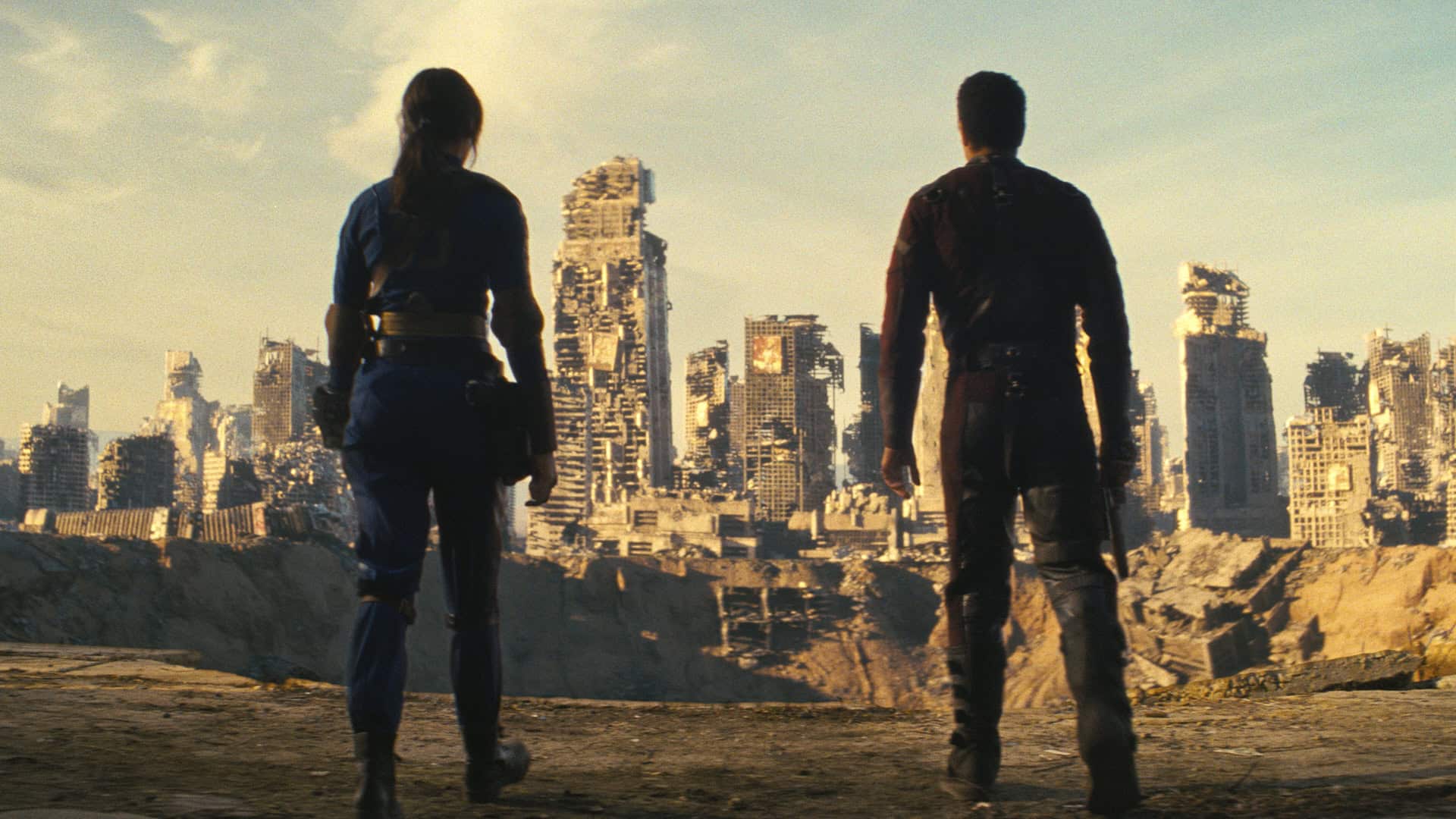The Wasteland is calling once more. Fallout Season 2 has officially completed filming as of May 7, 2025, and anticipation is skyrocketing. Confirmed by Amazon Prime Video via a celebratory behind-the-scenes clip of Walton Goggins (The Ghoul) peeling off his iconic prosthetics, the announcement marks a major milestone for one of Prime Video’s biggest breakout hits.

What’s New in Season 2: Welcome to New Vegas
Season 1 left viewers with a radioactive cliffhanger, and the follow-up promises to expand the show’s universe in a big way. As revealed by set leaks and heavily teased in the finale, Season 2 will bring fans to one of the most beloved locations in the Fallout game franchise — New Vegas. The Mojave Wasteland is a rich and chaotic sandbox, best known from Fallout: New Vegas (2010), a game still praised for its branching narratives, moral ambiguity, and iconic factions.
The show’s creative team seems poised to tap into this legacy, with hints pointing to the inclusion of Caesar’s Legion — a brutal, Roman-inspired militaristic faction — and the sinister White Glove Society, a cannibalistic elite club masquerading as high society. These groups could provide deeply thematic conflict in contrast to the bureaucratic evil of Vault-Tec, which Season 1 only began to explore.
Returning Characters and Story Continuation
Season 2 will continue the story of Lucy MacLean (Ella Purnell) and The Ghoul (Walton Goggins) as they journey deeper into the irradiated heart of America, now on the trail of Lucy’s father, Hank (Kyle MacLachlan). In Season 1’s jaw-dropping finale, Hank was revealed to have sinister ties to Vault-Tec and was last seen heading toward the Mojave. This pursuit sets up a high-stakes cat-and-mouse dynamic, layered with betrayals, new alliances, and increasingly blurred lines between good and evil.
With Goggins’ performance earning critical acclaim for bringing both menace and tragic depth to The Ghoul, Season 2 is expected to delve further into his backstory — possibly exploring his pre-Ghoul life and motivations. Meanwhile, Lucy’s transformation from Vault 33’s hopeful idealist into a hardened survivor continues to mirror the moral complexity fans expect from the Fallout universe.
Rapid Production and Release Timeline
While some fans expected a long wait after the May wrap date, Amazon surprised everyone by announcing a December 2025 premiere for Season 2. Post-production is expected to be fast-tracked, with Amazon seemingly eager to capitalize on the show’s massive success. Given Season 1’s record-breaking debut — one of Prime Video’s most-watched premieres of all time — the holiday release timing positions Fallout as a tentpole series alongside The Boys and The Rings of Power.
Season 3 Is Already Confirmed
Amazon’s confidence in Fallout is clear. Before Season 2 even airs, the show has already been renewed for a third season. This early greenlight suggests that showrunners Geneva Robertson-Dworet and Graham Wagner have mapped out a long-term arc — potentially expanding to other iconic locations from the games, like the Capital Wasteland (Fallout 3) or The Commonwealth (Fallout 4).
A Love Letter to Fans — And the Lore
The transition from video game to screen is notoriously difficult, but Fallout defied the odds. Season 1 struck a rare balance: satisfying longtime fans with deep lore references while remaining accessible to newcomers. With Season 2 diving headfirst into New Vegas territory — a setting loaded with fan expectations — the stakes are even higher.
If the writing continues to balance political satire, black comedy, and brutal storytelling as effectively as it did in Season 1, Fallout could cement its place as one of the best game-to-screen adaptations in television history.
Mark your calendars — the bombs may have fallen long ago, but the next chapter in Fallout is just around the corner this December 2025.
Best Fallout Games Ranked
The Fallout series has become one of gaming’s most loved franchises since its start in 1997. With its mix of post-nuclear settings, dark humor, and player choice, these games have won fans across many platforms. Players often debate which Fallout game stands as the best, with opinions varying based on story depth, gameplay mechanics, and overall world design.
Each game in the series offers something different, from the classic isometric views of early titles to the modern open-world 3D versions. The rankings of these games change depending on who you ask, with some loving the freedom of New Vegas while others prefer the crafting systems in Fallout 4. What makes these post-apocalyptic adventures special is how they let players shape their own stories in a world that has been broken and rebuilt.
1. Fallout: New Vegas
Fallout: New Vegas stands at the top of many fan rankings, and for good reason. Released in 2010, this game took the Fallout series to new heights with its branching storylines and deep role-playing elements.
The game is set in the Mojave Wasteland, a post-apocalyptic version of Nevada. Players take on the role of a courier who gets shot in the head and left for dead, only to embark on a quest for answers and revenge.
What makes New Vegas special is its incredible writing. The characters feel real, with clear motivations and complex personalities that draw you into their world.
Player choice matters in New Vegas more than any other Fallout title. The four main factions – NCR, Caesar’s Legion, Mr. House, and Yes Man – offer truly different paths through the game.
Combat in New Vegas improved on Fallout 3’s foundation. The addition of iron sights made gunplay more satisfying, while the expanded crafting system gave players more options.
The game’s DLCs are among the best in gaming history. Dead Money, Honest Hearts, Old World Blues, and Lonesome Road each tell unique stories that connect to the main plot in surprising ways.
Despite being developed in just 18 months, New Vegas shows remarkable depth. This rushed schedule did cause bugs at launch, but patches fixed most issues over time.
New Vegas has been voted the best Fallout game in community polls. Its blend of dark humor, moral complexity, and genuine role-playing freedom keeps players coming back years later.
The game’s setting feels authentic to the original Fallout games. Obsidian Entertainment, which included developers from the original Fallout team, captured the series’ spirit perfectly.
Even with dated graphics by today’s standards, New Vegas creates a memorable atmosphere. The desert landscape, western themes, and swinging tunes of Radio New Vegas form a unique gaming experience that fans still praise.
2. Fallout 3
Fallout 3 marked a major shift for the series when Bethesda took over. The game moved from isometric view to a fully 3D world, bringing players into the Capital Wasteland around Washington, DC.
Many fans consider Fallout 3 one of the best in the series due to its atmosphere. The destroyed monuments and bleak landscape create a unique feel that later games couldn’t quite match.
The game introduced the VATS combat system. This helped bridge the gap between the original turn-based games and modern first-person shooters by slowing time and letting players target specific body parts.
Exploring the wasteland became a true joy in Fallout 3. Each location told its own story through notes, terminal entries, and environmental details. The game rewarded curious players who ventured off the main path.
The main story followed the Lone Wanderer searching for their father. While some found this plot basic, the side quests truly shined. From deciding the fate of Megaton to helping ghouls reach their spaceship dreams, these stories gave the game depth.
Fallout 3 has aged less gracefully than newer entries in terms of gameplay. The shooting mechanics feel stiff by modern standards, and some systems seem clunky now.
The DLC expanded the game in meaningful ways. Point Lookout added a creepy swamp to explore, while Broken Steel fixed the original ending that many players disliked.
The moral choices in Fallout 3 sometimes felt black and white. Players could be very good or very evil, with less room for the gray areas that later games would explore.
Despite its flaws, Fallout 3 created the template for modern Fallout games. It successfully brought the series into 3D while keeping the dark humor and post-apocalyptic feel that fans loved.
The game’s soundtrack perfectly matched its setting. From the upbeat Galaxy News Radio tunes to the haunting background music, the audio design helped create the Capital Wasteland’s unique mood.
3. Fallout 2
Fallout 2 stands as a beloved entry in the series, building on what made the original game special. Released in 1998, it expanded the post-apocalyptic world with more locations, characters, and quests.
Many fans consider it the pinnacle of Fallout. The game introduced the dark humor that helps set Fallout apart from other post-apocalyptic games. This unique tone balances the grim setting with moments of levity.
The story picks up 80 years after the first game. Players take on the role of “The Chosen One,” a tribal descendant of the original protagonist. The main quest sends them searching for a Garden of Eden Creation Kit to save their struggling village.
Fallout 2 improved on the original with more complex character interactions. The game offers players more ways to solve problems through dialogue, stealth, or combat. These choices give each playthrough a different feel.
The world of Fallout 2 feels more alive than its predecessor. Towns have distinct personalities and problems. The characters players meet along the way have more depth and often surprising backstories.
Combat received upgrades too. The turn-based system includes more weapons and tactical options. Players can aim at specific body parts for different effects, adding strategy to each fight.
Fallout 2 ranks highly on many lists of the best Fallout games. Its rich storytelling and player freedom created a template that later games would follow.
The game’s impact continues today. Many modern RPGs trace their DNA back to the systems Fallout 2 pioneered. Its influence extends beyond the Fallout series to the broader gaming landscape.
Despite its age, Fallout 2 remains playable and enjoyable today. The dated graphics might turn off some players, but the strong writing and game design still shine through.
4. Fallout 4
Fallout 4 stands as a major evolution in the post-apocalyptic series. Released in 2015, it brought players to the Commonwealth, a wasteland version of Boston and its surrounding areas.
The game introduced a robust crafting system that let players build entire settlements. This feature added a new layer to gameplay, giving survivors a chance to rebuild the world rather than just explore it.
Combat improved with better shooting mechanics and a refined V.A.T.S. system. The addition of power armor as a mini-vehicle rather than just another outfit changed how players approached dangerous situations.
Graphically, Fallout 4 made a big jump from previous games. The world felt more alive with improved lighting, weather systems, and more detailed environments.
Character customization became more complex and visual. Players could shape their character’s face in great detail before stepping into the wasteland.
The story follows a parent searching for their kidnapped child after waking from a vault. This personal tale gave players a clear motivation while still allowing freedom to explore.
Companions in Fallout 4 had more personality and unique quests. Building relationships with these characters added emotional depth to the adventure.
The game received mixed reactions for its simplified dialogue system. The four-option wheel limited complex conversations but kept the pace moving.
Many rank Fallout 4 highly in the series. Some fans consider it “definitely the best” despite the strengths of older titles.
Faction choices became a central part of the story. Players picked sides between groups like the Brotherhood of Steel, the Institute, and the Railroad.
The Far Harbor and Nuka-World expansions added substantial content after release. These DLCs brought new areas, stories, and gameplay options that extended the experience.
Mods flourished on all platforms, letting players customize their experience. This support helped maintain an active community years after the game’s launch.
While not perfect, Fallout 4 succeeded in bringing the series to new technical heights. Its blend of action, exploration, and base-building created an experience that kept players engaged for hundreds of hours.
5. Fallout
The original Fallout game was released in 1997 and started the iconic post-apocalyptic series. This first entry introduced players to the wasteland setting after nuclear war devastated the United States.
The game features turn-based combat and an isometric view that was revolutionary for its time. Players take on the role of the Vault Dweller, who must leave the safety of Vault 13 to find a water chip.
Fallout’s greatest strength is its deep role-playing systems. The game gives players true freedom to make choices that affect the world around them.
The writing in Fallout stands out with its dark humor and serious themes. It tackles topics like survival, isolation, and the rebuilding of society in clever ways.
Despite its age, many Fallout fans still appreciate the original game. Some ranking lists place it higher than newer titles like Fallout 76.
The world of Fallout feels alive thanks to its well-designed locations. Places like The Hub and Junktown show how communities might form after disaster strikes.
Character creation uses the S.P.E.C.I.A.L. system, which lets players build unique characters. This system has stayed with the series through all its games.
The graphics are dated by today’s standards, but they had charm and clarity. The art style helps tell the story of a world stuck between 1950s optimism and nuclear ruin.
While newer Fallout games have improved on many features, the first game deserves respect. It laid the groundwork for what would become one of gaming’s most famous series.
For new players, the original Fallout might feel tough to get into. The interface and gameplay systems take time to learn compared to modern games.
Still, for those interested in gaming history or dedicated RPG fans, the original Fallout offers an experience worth trying. Its influence can be seen in many modern games today.
6. Fallout Tactics: Brotherhood of Steel
Fallout Tactics stands apart from other games in the series with its focus on squad-based combat rather than solo exploration. Released in 2001, this spin-off takes players through the wasteland as members of the Brotherhood of Steel.
Unlike mainline Fallout games, Tactics pushes role-playing elements to the background. The game emphasizes tactical combat and mission completion instead of the open-world questing that fans know from other titles.
Players command a squad of up to six characters through various missions. The game offers both turn-based and real-time combat options, giving players flexibility in how they approach encounters with enemies.
The setting explores the Midwest region of the post-nuclear United States. This area wasn’t covered in earlier games, allowing Tactics to expand the Fallout world while staying true to its gritty atmosphere.
Character customization remains a strong point. Players can create squad members with different skills and specialties, making each playthrough feel unique. The stat system follows the SPECIAL framework familiar to Fallout fans.
Weapons and equipment choices are plentiful. From simple pistols to advanced energy weapons, players have many options to outfit their team. Vehicle combat adds another layer to the tactical experience.
The game received mixed reviews when it launched. Some players appreciated the fresh take on combat, while others missed the deeper role-playing elements of previous games.
In rankings of Fallout games, Tactics typically lands in the middle of the pack. Den of Geek places it at number 6, recognizing its unique contribution to the series despite its departure from tradition.
While not considered a main entry in the series, Fallout Tactics offers a worthwhile experience for fans interested in the Brotherhood of Steel faction. Its combat-focused gameplay provides a different perspective on the post-apocalyptic world.
The game’s story, though less complex than other Fallout titles, explores interesting themes about technology and survival. It adds depth to the Brotherhood’s history and mission in the wasteland.
7. Fallout Shelter
Fallout Shelter brought the post-apocalyptic world to mobile devices in 2015. This free-to-play game puts players in charge of their own Vault as the Overseer.
Unlike other games in the series, Fallout Shelter focuses on management rather than exploration. Players build rooms, assign dwellers to jobs, and keep everyone happy and safe.
The game uses a charming cartoon art style that makes the usually grim Fallout world more approachable. The colorful design and simple interface make it easy for anyone to play.
Resource management is key to success. Water, food, and power must be balanced to keep your vault running smoothly. When supplies run low, your dwellers will let you know through their declining happiness.
Sending dwellers to explore the wasteland adds excitement to the gameplay. These brave souls can find caps, weapons, and outfits to improve life in the vault.
Special events like raider attacks and radroach infestations keep players on their toes. These challenges test how well you’ve designed your vault and equipped your dwellers.
The game ranks near the middle of most Fallout game lists. It doesn’t offer the deep storytelling of other titles but provides simple fun that’s easy to pick up.
Fallout Shelter serves as a great introduction to the series for new players. Its simplified systems give a taste of the Fallout universe without overwhelming newcomers.
The game received regular updates after launch, adding quests and new features. These additions helped keep the experience fresh for long-term players.
Despite its mobile origins, Fallout Shelter later expanded to consoles and PC. This wider release helped it reach an even larger audience than initially expected.
8. Fallout 76
Fallout 76 marks Bethesda’s first attempt at a multiplayer experience in the Fallout universe. Released in 2018, the game faced harsh criticism at launch for its many technical issues and lack of human NPCs.
Players explore a vast map set in West Virginia, known as Appalachia. The setting features diverse regions from forests to toxic wastelands, giving players plenty to explore.
The game takes place in 2102, making it the earliest game in the Fallout timeline. This setting allows players to witness the early effects of nuclear devastation before other Fallout games.
Bethesda has improved the game significantly since launch. Major updates like Wastelanders added human NPCs and dialogue choices that fans wanted from the beginning.
The building system from Fallout 4 returns with C.A.M.P.S., allowing players to build bases anywhere on the map. This feature adds a creative element that many players enjoy.
Combat follows similar mechanics to Fallout 4, though V.A.T.S. works differently to accommodate the multiplayer format. It now works in real-time rather than slowing down time.
Events bring players together for cooperative challenges. These range from fighting massive enemies to completing objectives as a team.
The ranking on most lists places Fallout 76 near the bottom of the Fallout series. Both GamesRadar and Den of Geek position it at number 8 in their rankings.
Despite its rough start, some players find value in the multiplayer aspects. The ability to team up with friends offers a fresh take on the post-apocalyptic world.
The game continues to receive updates, showing Bethesda’s commitment to improving the experience. Each update has brought the game closer to what fans expected at launch.
For those who enjoy online gaming with friends, Fallout 76 offers unique experiences not found in other Fallout titles. The shared world creates moments impossible in single-player games.
While not considered the best Fallout game by most critics, 76 has carved out its own niche in the series. Its ongoing development shows how games can evolve over time with proper support.
9. Fallout 2: A Post Nuclear Role Playing Game
Fallout 2 stands as a beloved classic in the series. Released in 1998, this turn-based RPG expanded on the foundation of its predecessor with more depth and content.
Many fans consider Fallout 2 the pinnacle of the Fallout series. It built upon the original game’s lore while introducing the dark humor that makes Fallout unique among post-apocalyptic games.
The game puts players in the role of “The Chosen One,” a descendant of the first game’s protagonist. Your mission is to find a Garden of Eden Creation Kit (G.E.C.K) to save your dying village.
Fallout 2 improved on combat mechanics and offered more player choices. These improvements made the gameplay more engaging than the original.
The world of Fallout 2 feels alive and full of interesting characters. Players can spend countless hours just exploring the wasteland and finding new stories.
Character creation and development are deep and rewarding. Your choices in skills and traits truly matter, affecting how you can approach different situations.
The writing in Fallout 2 shines with its mix of serious themes and humor. It tackles complex issues while keeping a sense of fun that later games tried to copy.
Its ranking varies among fans, with some lists placing it as high as number 3 or number 4. Some hardcore fans even rank it as the best Fallout game ever made.
The game’s interface might feel dated to new players. Still, those who push past the learning curve find a rich RPG experience that holds up well.
Towns in Fallout 2 feel distinct and memorable. Each has its own problems, personalities, and quests that pull players into the world.
The game’s freedom to solve problems in multiple ways was ahead of its time. You can talk, sneak, or fight your way through most situations based on how you build your character.
10. Fallout: A
Fallout: A, often simply called the original Fallout, started it all back in 1997. This game introduced players to the post-nuclear wasteland that would become one of gaming’s most iconic settings.
The original title laid the groundwork for all future Fallout games. It featured turn-based combat and a character system that let players build unique survivors with different skills and abilities.
Players stepped out of Vault 13 with a simple mission – find a water chip to save their home. This straightforward quest quickly grew into something much bigger as they explored the wasteland.
The game’s dark humor and grim setting made it stand out from other RPGs of its time. These elements would later become hallmarks of the Fallout series.
Fallout: A wasn’t as big as later games in the series. The map was smaller and there were fewer side quests. Still, it packed a lot of content into its world.
Players could solve problems in many ways. They could talk, sneak, or fight their way through challenges. This freedom to choose became a key part of what makes Fallout games special.
The game had multiple endings based on player choices. This approach to storytelling was ahead of its time and set a standard for future RPGs.
Graphics might look dated now, but the art style created a perfect mood. The retro-futuristic look mixed 1950s optimism with post-nuclear destruction in a unique way.
While it may rank lower on some lists, Fallout: A deserves respect for creating the foundation that later games built upon. Many fans still consider it the pinnacle of the Fallout experience.
The game’s isometric view and turn-based combat might feel old to new players. Yet these systems allowed for deep strategic gameplay that many veterans of the series still miss.
Overview of the Fallout Series
The Fallout series has transformed from a niche isometric RPG into one of gaming’s most recognized franchises, known for its post-apocalyptic setting and dark humor. Its distinctive retro-futuristic aesthetic combines 1950s American optimism with nuclear devastation.
Evolution of Gameplay Mechanics
Fallout began in 1997 as a turn-based isometric RPG focused on player choice and consequences. The original games featured the iconic S.P.E.C.I.A.L. system for character attributes and skills-based progression.
When Bethesda acquired the series, Fallout 3 marked a dramatic shift to first-person 3D gameplay with the introduction of V.A.T.S. (Vault-Tec Assisted Targeting System). This system paused combat and allowed players to target specific body parts.
Later titles expanded crafting systems. Fallout 4 added settlement building, while Fallout 76 moved into online multiplayer territory.
Each game maintained the series’ commitment to player freedom. The dialogue systems have changed significantly too, from text-heavy options to the controversial four-choice wheel in Fallout 4.
Impact on the RPG Genre
Fallout’s greatest contribution to RPGs is its emphasis on meaningful choices. Unlike many games with binary moral systems, Fallout presents complex situations with no clear “right” answers.
The series pioneered the concept of faction reputation systems. New Vegas in particular is praised for its intricate faction dynamics where choices affect multiple groups simultaneously.
Fallout’s approach to world-building has influenced countless games. Its rich lore is discovered through environmental storytelling, terminal entries, and audio logs rather than forced exposition.
The series proved that mature themes and dark humor could coexist in gaming. Topics like slavery, cannibalism, and political extremism are addressed with surprising depth.
Many modern RPGs now feature Fallout-inspired systems like perk trees, companion relationships, and open worlds filled with meaningful side content instead of empty space.
Understanding Fallout Game Themes
The Fallout series stands out for its distinctive themes that blend dark humor with post-nuclear devastation. These games explore human nature when society collapses and new power structures emerge from the ashes.
Post-Apocalyptic Atmosphere
Fallout’s world is built on the ruins of a retro-futuristic 1950s America destroyed by nuclear war. This unique setting creates a stark contrast between optimistic pre-war aesthetics and the harsh reality of survival.
The games feature iconic elements like Vault-Tec shelters, power armor, and mutated creatures that have become hallmarks of the series. Radiation plays both a gameplay mechanic and storytelling device, transforming landscapes and creatures alike.
Music choices amplify the atmosphere, with vintage songs from the likes of The Ink Spots creating an eerie juxtaposition. The games use visual storytelling through abandoned buildings and personal notes to tell stories of the final moments before bombs fell.
Each game region showcases different recovery stages, from the Capital Wasteland’s barren landscape to New Vegas’s rebuilt society.
Narrative and Storytelling Elements
Fallout games excel at player choice and moral ambiguity. The series is known for its branching storylines where decisions have lasting consequences on the game world.
Factions form a central part of Fallout’s storytelling, with groups like the Brotherhood of Steel, NCR, and Institute representing different ideologies for rebuilding society. Players must choose which vision of the future they support.
The dark humor that makes Fallout unique appears throughout, from amusing robot personalities to absurd quests. This humor balances the bleak setting with moments of levity.
Companion characters add depth through personal stories that reflect the world’s harsh realities. Their reactions to player choices create emotional investment and show different perspectives on wasteland life.
Frequently Asked Questions
Fallout games offer different experiences based on storylines, difficulty levels, and features. Players often wonder which game ranks best for their preferences and playing style.
What is the ranked order of Fallout games based on storyline quality?
When ranking Fallout games by storyline quality, Fallout: New Vegas typically comes out on top. Its branching narrative and multiple endings give players true choice.
Fallout 3 often ranks second with its emotional main quest about finding your father. The story hits emotional notes while exploring the Capital Wasteland.
Fallout 2 offers a rich tribal storyline that many fans appreciate for its depth and humor. The writing quality stands out even today.
Fallout 4’s story about finding your son receives mixed reviews. Some enjoy the parent-child connection, while others feel the main story lacks the freedom of earlier games.
The original Fallout has a simple but effective story about saving your Vault. Its straightforward approach established the series’ tone.
Which Fallout game is considered the best for new players to start with?
Fallout 4 is often recommended for newcomers due to its streamlined systems and modern controls. The building mechanics and improved gunplay make it accessible.
Fallout 3 also works well for beginners. Its open world is less overwhelming than New Vegas, and the main story provides clear direction.
Players familiar with RPGs might start with New Vegas for its excellent writing and game systems. However, its multiple factions and choices can feel complex to new players.
How do the Fallout games compare when ranked by gameplay difficulty?
The original Fallout and Fallout 2 present the highest difficulty curve. Their turn-based combat and limited guidance create steep learning curves for modern gamers.
Fallout: New Vegas features challenging survival modes and combat, especially in its DLCs. The Hardcore mode adds realistic needs for food, water, and sleep.
Fallout 3 sits in the middle difficulty-wise. Its VATS system helps less skilled players manage combat effectively.
Fallout 4 offers the most forgiving experience with improved shooting mechanics. Players can succeed through direct combat without relying heavily on stats or special builds.
Which Fallout game is the most critically acclaimed across various gaming platforms?
Fallout: New Vegas receives the highest praise from critics and fans alike. Its rich storytelling and meaningful choices earn it top spots on many ranking lists.
Fallout 3 won numerous Game of the Year awards when released. Critics praised its successful transition of the series to 3D.
Fallout 2 holds high ratings among PC gamers and RPG enthusiasts. Its complexity and depth continue to impress players years after release.
Fallout 4 received mixed critical reception. Many praised its improved gameplay while criticizing simplified dialogue and RPG elements.
In what chronological order should the Fallout games be played for the best experience?
Playing in release order gives players the best understanding of how the series evolved: Fallout, Fallout 2, Fallout 3, New Vegas, then Fallout 4.
Some prefer playing in timeline order: Fallout, Fallout 2, Fallout 3, Fallout 4, then New Vegas (which occurs after Fallout 3 but before Fallout 4).
Many fans recommend starting with either Fallout 3 or New Vegas for those uncomfortable with older game mechanics. These games capture the Fallout experience while remaining accessible.
What are the defining features that determine the ranking of Fallout games?
Story depth and branching narratives greatly influence rankings. Games offering meaningful choices typically rank higher among fans.
World design plays a major role, with New Vegas and Fallout 3 praised for their atmospheric and interesting environments.
Character development systems affect rankings significantly. Games with more role-playing options generally receive better ratings from hardcore fans.
Combat mechanics matter too. Older games focus on strategic turn-based combat. Meanwhile, newer titles offer more action-oriented experiences.
Side quests quality often separates higher-ranked games from lower ones. New Vegas particularly shines with memorable side missions that impact the world.







